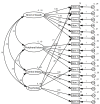The Cross-Cultured Validity and Reliability of the Vietnamese Nijmegen Questionnaire
- PMID: 40065854
- PMCID: PMC11890985
- DOI: 10.7759/cureus.78709
The Cross-Cultured Validity and Reliability of the Vietnamese Nijmegen Questionnaire
Abstract
Introduction: The Nijmegen Questionnaire assesses hyperventilation syndrome (HVS), but a validated Vietnamese version is lacking. This study investigates the cross-culture validity, structural validity, and reliability of the Vietnamese Nijmegen questionnaire (VNQ) for screening HVS in primary healthcare settings.
Methods: Following Beaton's guidelines, translation and adaptation involved two independent expert panels for content validity. Exploratory factor analysis (EFA) and confirmatory factor analysis (CFA) examined the VNQ's structure. Reliability was assessed via Cronbach's alpha, intraclass correlation coefficients, Bland-Altman analysis, and linear regression.
Results: Content validity was excellent (all I-CVIs > 0.79 and all S-CVIs > 0.8). EFA revealed a four-factor structure, including the original three NQ factors and a new "psychology" factor, confirmed by CFA. Cronbach's alpha and ICC values exceeded 0.7 and 0.8, respectively, indicating good internal consistency and test-retest reliability. Bland-Altman analysis showed low systematic error, and linear regression revealed no proportional bias (P > 0.05).
Conclusion: The VNQ demonstrates excellent content validity, acceptable structural validity, and reliable psychometric properties for HVS screening in primary healthcare settings.
Keywords: cross-cultured validity; hyperventilation syndrome; nijmegen questionnaire; structural validity; test–re-test reliability.
Copyright © 2025, Nguyen et al.
Conflict of interest statement
Human subjects: Consent for treatment and open access publication was obtained or waived by all participants in this study. Ethics Committee at the University of Medicine and Pharmacy at Ho Chi Minh City issued approval 1187 HĐĐĐ-ĐHYD. Animal subjects: All authors have confirmed that this study did not involve animal subjects or tissue. Conflicts of interest: In compliance with the ICMJE uniform disclosure form, all authors declare the following: Payment/services info: All authors have declared that no financial support was received from any organization for the submitted work. Financial relationships: All authors have declared that they have no financial relationships at present or within the previous three years with any organizations that might have an interest in the submitted work. Other relationships: All authors have declared that there are no other relationships or activities that could appear to have influenced the submitted work.
Figures


References
-
- Severely impaired health-related quality of life in chronic hyperventilation patients: exploratory data. Chenivesse C, Similowski T, Bautin N, Fournier C, Robin S, Wallaert B, Perez T. Respir Med. 2014;108:517–523. - PubMed
-
- Relationships between measures of dysfunctional breathing in a population with concerns about their breathing. Courtney R, Greenwood KM, Cohen M. J Bodyw Mov Ther. 2011;15:24–34. - PubMed
LinkOut - more resources
Full Text Sources
